
The Percheron is a breed of draft horse that originated in the Huisne river valley in western France, part of the former Perche province, from which the breed takes its name. Usually gray or black in color, Percherons are well-muscled, and known for their intelligence and willingness to work. Although their exact origins are unknown, the ancestors of the breed were present in the valley by the 17th century. They are believed to descend from war horses. Over time, they began to be used for pulling stagecoaches; and later, for agriculture and hauling heavy goods. In the late 18th and early 19th centuries, Arabian blood was added to the breed. Exports of Percherons from France rose exponentially in the late 19th century, and the first purely Percheron stud book was created in France in 1893.
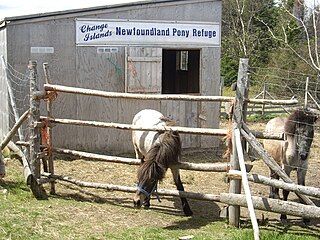
The Newfoundland pony is a breed of pony originating in Newfoundland, Canada. They are sturdy and muscular ponies, found in many colors, including the relatively rare white coloration. The Newfoundland developed from a mix of English, Irish and Scottish pony breeds brought to Newfoundland by settlers over a period of four centuries. Initially free-roaming, they crossbred to produce the modern type. They were used by settlers as draft and multi-purpose ponies until the mid-20th century, when they were brought almost to the point of extinction by mechanization and slaughter. The population rebounded slightly after the formation of a breed registry in 1980, but still remains low. In 1997, the Newfoundland pony was declared a heritage breed of Newfoundland and Labrador, which afforded it protection under the law, but the breed has not yet been recognized under the Canadian federal Animal Pedigree Act. As of 2008, there were 248 registered ponies of breeding age, out of a total population of 361. In 2013, the widely dispersed breeding population is still estimated at between 200 and 250 animals.
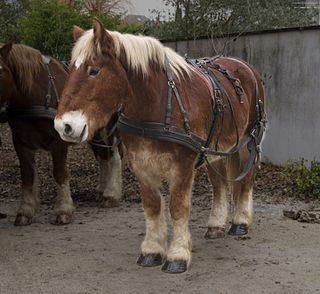
The Trait Breton is a French breed of draught horse. It originated in Brittany, in north-west France, from cross-breeding of local horses with various other breeds. It is strong and muscular, and often has a chestnut coat.

The Auxois is a horse breed from eastern France. It is a large breed, with some individuals weighing over 910 kilograms (2,010 lb), bred for horse meat, agricultural work and leisure pursuits. Overall, members of the breed are solid and muscular in appearance. They are usually bay or bay roan in color, although some other colors are accepted by the breed registry, and are known for their power and docility.

The Trait du Nord, previously also known as Ardennais du Nord or Ardennais de type Nord, is a breed of heavy draft horse developed and bred in the area of Hainaut in western Belgium and in northeastern France. Originally considered a subtype of the Ardennes, it was recognized as an individual breed with the opening of a studbook in 1903. Developed in the fertile Flemish grasslands, it was bred for size and pulling power for agricultural work. By 1855, the horses bred near Hainaut were considered by some veterinarians to be superior to other Flemish draft breeds. The Trait du Nord was used extensively in mining from the late 19th century through 1920, with lesser use continuing through the 1960s.
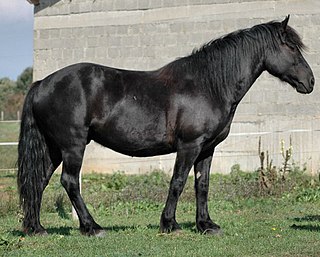
The Mérens, Cheval de Mérens or Caballo de Merens, still occasionally referred to by the older name of Ariégeois pony, is a small, rustic horse native to the Pyrenees and Ariégeois mountains of southern France, where the river Ariège flows, and northern Spain, near Andorra. Two general types, a small, light traditional mountain horse and a taller, sportier modern type, are found. Always black in color, Mérens must meet strict physical standards in order to be registered in the stud book. The breed is known for its sure-footedness on mountain terrain, as well as for its endurance, hardiness and docility. The French breed registry organizes regional offices, and partners with other national organizations in Europe to preserve and promote the breed. The organization enforces rigorous selection of breeding stock, with a goal of increasing quality in the breed. In the past, the Mérens was used for farm work, draft work and as pack horses. Today it is mainly used as a saddle horse, although some members of the breed have been successful in carriage driving. Many Mérens are taken on an annual transhumance, in which they are moved higher in the mountains during the summer and into the valleys for the winter. An old practice, it fell into disfavor, but has recently re-emerged.

The Poitevin or Poitou is a French breed of draft horse. It is named for its area of origin, the former province of Poitou in west-central France, now a part of the region of Nouvelle-Aquitaine. It was formed in the seventeenth century when horses of Flemish or Dutch origin, brought to the area by engineers working to drain the Marais Poitevin, interbred with local horses. Although it has the size and conformation of a draft horse, the Poitevin has never been bred for draft abilities, and has been little used for draft work. Its principal traditional use was the production of mules. Poitevin mares were put to jacks of the large Baudet du Poitou breed of donkey; the resulting Poitevin mules were in demand for agricultural and other work in many parts of the world, including Russia and the United States. In the early twentieth century there were some 50,000 brood mares producing between 18,000 and 20,000 mules per year.

The Anglo-Norman horse is a warmblood horse breed developed in Lower Normandy in northern France. A major center of horse breeding, the area had numerous regional types that were bred to one another and then crossed with Thoroughbreds to form the Anglo-Norman. Various body types developed within the Anglo-Norman breed, two of which were split off to form the Norman Cob and French Trotter. The remaining types were eventually standardized, although there remained some criticism of the "hybrid" nature of the breed's conformation. However, it is successful as an international sport horse, especially in the sport of show jumping. The Anglo-Norman also contributed to the development of several other breeds in Europe and Asia.
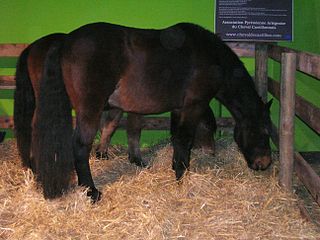
The Castillonais or Cheval Ariègeois de Castillon , also formerly called Cheval du Biros or Saint-Gironnais, is an ancient breed of small rustic saddle-horse from the Ariège département of south-western France. It may be dark bay or seal brown. It stands 135–155 centimetres at the withers, with an average height of about 145 cm. It is used principally for trekking and for driving.

The Norman Cob or Cob Normand is a breed of light draught horse that originated in the region of Normandy in northern France. It is of medium size, with a range of heights and weights, due to selective breeding for a wide range of uses. Its conformation is similar to a robust Thoroughbred, and it more closely resembles a Thoroughbred cross than other French draught breeds. The breed is known for its lively, long-striding trot. Common colours include chestnut, bay and seal brown. There are three general subsets within the breed: horses used under saddle, those used in harness, and those destined for meat production. It is popular for recreational and competitive driving, representing France internationally in the latter, and is also used for several riding disciplines.

The Henson Horse, or Cheval de Henson, is a modern horse breed from northeast France. It was created by the selective breeding of light saddle horses with the smaller, heavier Norwegian Fjord horse to create small horses suitable for the equestrian vacation industry. The breeders' association, Association du Cheval Henson, was formed in 1983. In 1995 the studbook was closed to horses not born from Henson parents, and in 2003 the breed was officially recognised by the French government agencies for horse breeding. A hardy breed of horse, each winter the broodmares and youngstock from several breeders are let loose together to graze freely in the wetland reserves in France.

The Bidet was a type of small horse from France, now extinct. It was a landrace developed principally in the area around Brittany, Morvan, Auvergne, Poitou, and Burgundy. It stood about 110–135 centimetres at the withers. Two distinct groups are documented, which were bred in a semi-feral state.

Marine Oussedik, born on May 20, 1967, is a painter, sculptor and an illustrator specialized in horses. In 1990, she graduated from ESAG Penninghen, the Higher College of Graphic Arts, and started exhibiting in Parisian galleries the following year. Immediately afterwards she was commissioned paintings by the Living Museum of the Horse in Chantilly to be permanently displayed in two rooms. At the same time she published a book, Les chevaux d'encre. Many art books would follow including Les chevaux du Sahara in 1998, Les chevaux du vent in 2002 and Les chevaux de rois in 2003. She would be rewarded by Prix Pégase for those last two books which testify to her passion for illustrations of all kind of horses, Arabians being her favorite. In 2014, she illustrated an art book dedicated to classical French riding with texts by Guillaume Henry.

A hot-blooded horse is an unscientific term from the field of horse breeding, coined by orientalists and popularized by various hippologists. It refers to a light horse with a lively temperament, primarily the oriental horse breeds of North Africa, the Near East and Central Asia. Such a name is also applied to some horse breeds descended from horses from these geographical regions, such as the Thoroughbred, Anglo-Arabian, and Namib horse.

Haguard horse, also known as the Hague pony or bidet de la Hague, is a breed of bidet horse native to the natural region of La Hague, in the Manche in Normandy.
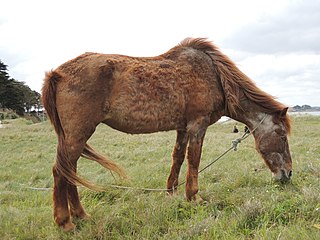
A geriatric horse is an equine that has a physical and mental decline, which generally prevents it from being used for most equestrian activities. The age of a geriatric horse could vary according to breed and riding use, with old age occurring more rapidly in Thoroughbred sport horses than in hardy ponies. Geriatric horse signs include tooth eruption, whitening of certain areas of the head, arching of the back and stiffness of locomotion. The animal also becomes more sensitive to the passing of the seasons.

In China, horses are present both physically and in art and beliefs, particularly those relating to astrology. In 1985, China had the world's largest herd of horses, numbering 11 million. China was at the origin of post houses in Eurasia. Since the 2000s sport and leisure riding have been developing in China, mainly for wealthy people.

The Zakynthos is a breed of generally black saddle and combined driving horses originating from the island of Zante, one of the Ionian Islands, in Greece. The origin of this breed is very recent, dating back to the 20th century. This breed is of Anglo-Arabian type and is genetically close to the Andravida. Genetic analysis shows that it has been crossed with the Thoroughbred. The Zakynthos may also be descended from the Nivernais-type Percheron. Its type remains unstable, and the breed has no official standards or identification documents.
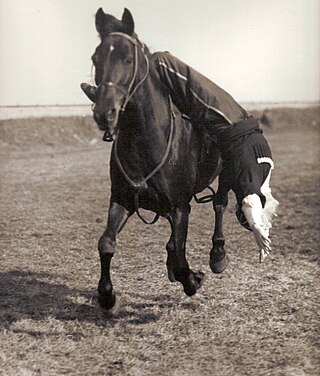
The presence of horses in Russia is attested by prehistoric fossils and has been constant throughout its history, particularly during the Soviet era, thanks to the integration of territories with a strong equestrian tradition. Trick riding stems from the military traditions developed by the Russian Cossacks. Russian equestrian culture is characterized by the exclusive use of the "duga" yoke, known in particular through the troika.
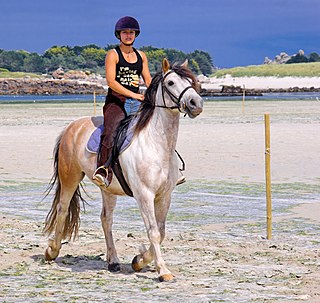
Leisure horses are intended for pleasure riding, and in particular for trail riding by private individuals. Difficult to define, it is above all an animal endowed with particular qualities, rather than a precise breed. It must be versatile and calm in character, with a willing and courageous mind. As early as the 1970s, breeders such as those of the Swiss Freiberger or Franches-Montagnes were breeding animals for this then-new use. The market for leisure horses is now buoyant. France has created "leisure qualifications" for this purpose.






















